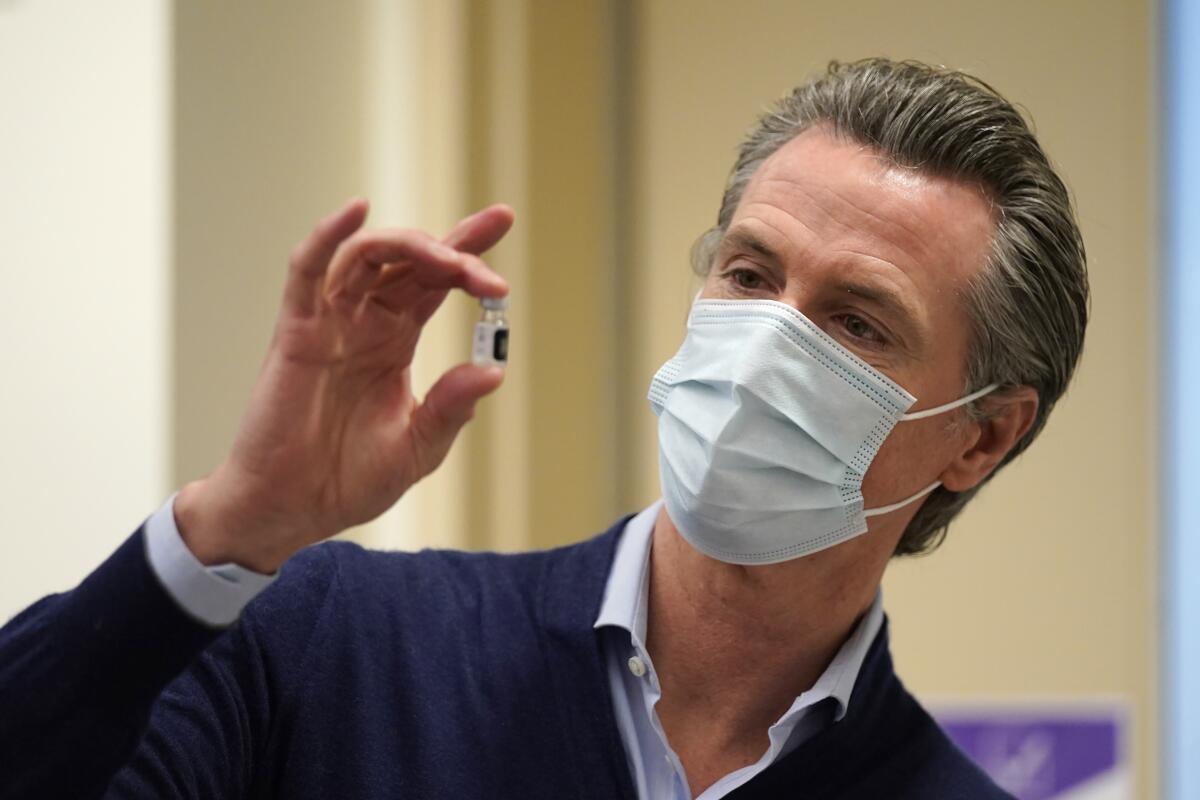Coronavirus stay-at-home order lifted for Greater Sacramento

- Share via
California is lifting the stay-at-home order for Greater Sacramento effective immediately, Gov. Gavin Newsom announced Tuesday, making the region the first to emerge from the additional restrictions on businesses and activities imposed in hopes of blunting the coronavirus surge and shielding hospitals from an overwhelming influx of patients.
The decision doesn’t mean it’s back to business as usual, though. Instead, the counties included in the region — Alpine, Amador, Butte, Colusa, El Dorado, Nevada, Placer, Plumas, Sacramento, Sierra, Sutter, Yolo and Yuba — will return to the state’s color-coded tier framework that determines how widely commercial and public spaces can reopen.
Nor does Tuesday’s announcement mean that the region is out of the woods when it comes to the latest coronavirus wave. Officials in Yuba County emphasized that, “Locally, ICU beds in our own hospital are still stressed, so all of us still need to keep doing all we can to prevent the spread of COVID-19.”
“California remains in its most intense surge to date,” Newsom said in a brief video message announcing the move. “But there are some good things to report. We’re starting to see some stabilization both in ICUs [and] in our positivity rate. We’re also starting to see the rate of growth for hospitalizations beginning to decline.”
Any positive news is welcome following the doom and gloom that’s accompanied COVID-19’s weekslong rampage throughout the Golden State.
“There is light at the end of this tunnel,” Newsom said.
With the stay-at-home order lifted, counties in Greater Sacramento now have the option of reopening hair salons and barbershops in a limited capacity, as well as allowing other businesses and establishments to resume some outdoor operations — including restaurants.
Greater Sacramento was placed under the stay-at-home order on Dec. 10, when the region’s available intensive care unit capacity dipped below 15%.
Those orders, when issued, remain in effect for at least three weeks. After that, a region can only emerge when its ICU availability, forecast four weeks out, is 15% or higher.
State officials have said there are four metrics that factor into that calculation: available ICU capacity, the rate of ICU admissions, the seven-day average coronavirus case rate and the virus transmission rate.
As of Tuesday, ICU availability in Greater Sacramento was 9.4%, according to the latest state data. The three other regions under a state stay-at-home order — the Bay Area, San Joaquin Valley and Southern California — were at 4.7%, 0% and 0%, respectively.
In the case of Southern California and the San Joaquin Valley, that metric doesn’t mean no beds are available, as the state uses a weighted formula to ensure that some remain open for non-COVID patients. It does, however, indicate that hospital capacity is stretched to the limit.
The state’s fifth defined region, rural Northern California, is the only one that’s never been subject to the latest stay-at-home restrictions since they were unveiled early last month.
But the region’s ICU availability had dipped to 17.6% as of Tuesday, according to the state — perilously close to the trigger point.
Dr. Mark Ghaly, California’s health and human services secretary, credited the regional stay-at-home system with helping tamp down coronavirus transmission.
“We did see some transmission reductions, and that is exactly the kind of relief our hospital systems needed to get through the week — and we hope it will carry forward a little bit longer,” he said during a briefing.
Though the state still anticipates “some increases in hospitalizations will come in the middle of the month,” Ghaly said, “we’re just hopeful it’s not as significant as we expected and, certainly, not as significant as it would have been had we not seen these reductions in transmission, in part, because of that regional stay-at-home order.”
Although hospitalizations have stabilized somewhat, they remain at a high level.
Since Jan. 3, the number of people with COVID-19 hospitalized across California has remained between 21,000 and 22,000. Since Thursday, the number of people in the ICU with COVID-19 has remained between 4,800 and 4,900.
Southern California has been hit particularly hard. In L.A. County, about 230 people are dying a day — the equivalent of a death every six minutes. Hospital morgues are so full that the National Guard has been called to help store corpses at the county coroner’s office.
Ambulances are waiting up to 17 hours to drop off patients at emergency rooms. Officials have warned that the quality of care at hospitals is suffering.
More to Read
Sign up for Essential California
The most important California stories and recommendations in your inbox every morning.
You may occasionally receive promotional content from the Los Angeles Times.












